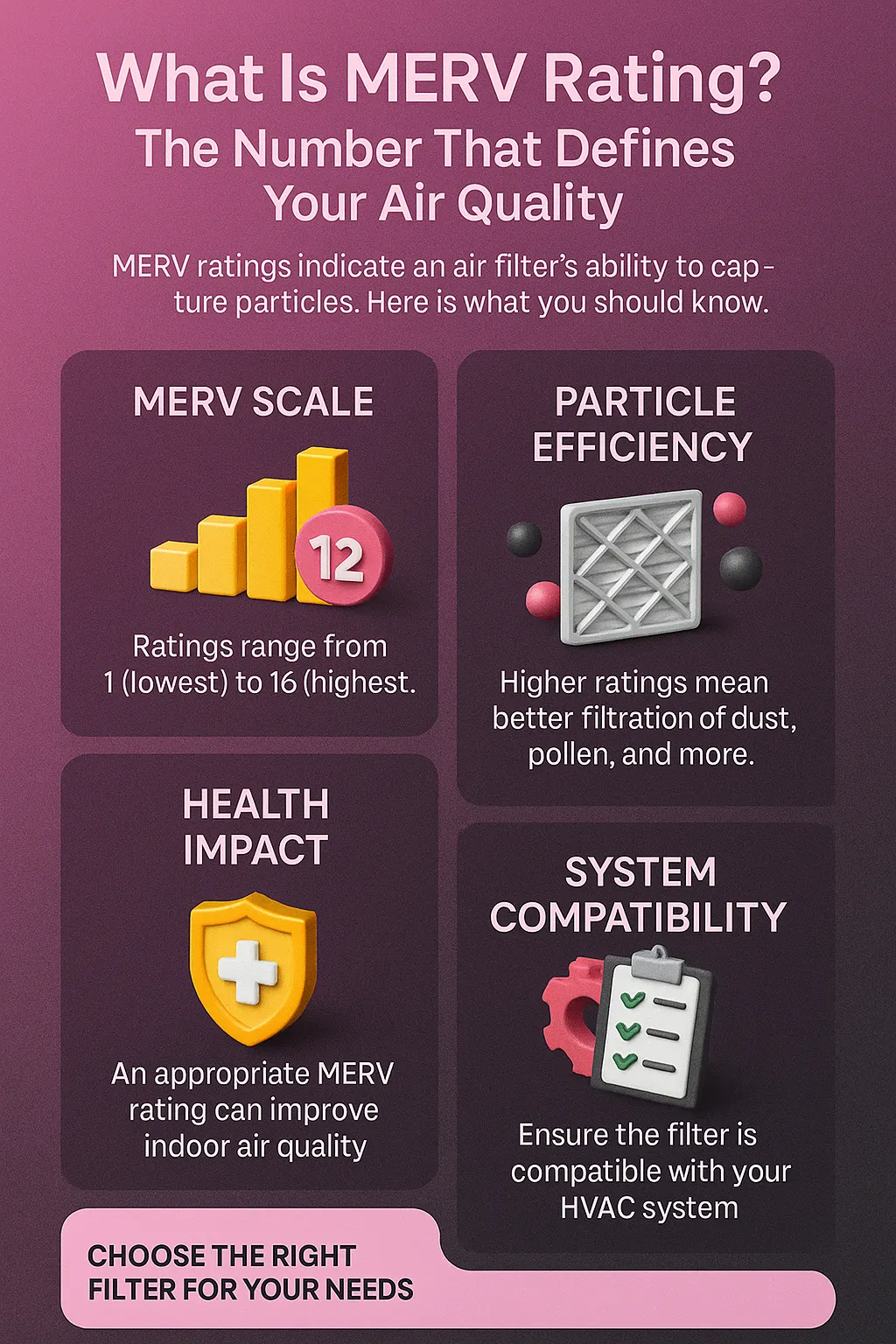So what is MERV rating? It’s the scale that measures how effectively a filter captures particles, from visible dust down to microscopic pollutants. But in practice, it’s much more personal. I’ve seen allergy sufferers go from constant sneezing to peaceful sleep simply by upgrading from a lower filter to a mid-range MERV. I’ve also seen homeowners push their systems too hard with ultra-high ratings, learning the hard way that more isn’t always better.
In this guide, I’ll not only explain the MERV scale and what each level means, but also share first-hand insights from years of real-world use—helping you cut through the confusion, avoid costly mistakes, and make the choice that leads to cleaner, healthier air in your own space by understanding what is MERV rating? and how it impacts your air quality.
Top Takeaways
MERV = efficiency. Higher rating = smaller particles captured.
MERV 8–13 = best for most homes. Clean air + good system performance.
MERV 13+ = extra protection. Captures smoke, bacteria, some viruses.
Small upgrades matter. 1–2 levels up can ease allergies and reduce dust.
Replace often. Every 1–3 months for best results.
How MERV Ratings Define Air Quality
The MERV rating—short for Minimum Efficiency Reporting Value—is a scale created by ASHRAE (the American Society of Heating, Refrigerating and Air-Conditioning Engineers). It measures how effectively an air filter captures particles of different sizes, ranging from MERV 1 to MERV 20.
MERV 1–4: Capture only large particles like dust and lint. Protects the HVAC system but offers little improvement in air quality.
MERV 5–8: A common choice in homes. Filters out pollen, mold spores, and pet hair. Improves comfort for allergy sufferers.
MERV 9–12: A stronger option. Captures smaller particles such as fine dust and pet dander. Useful for families with asthma or more sensitive lungs.
MERV 13–16: High-level protection. Traps bacteria, smoke, and even some airborne viruses. Found in hospitals and schools, but also practical for homes if the system allows.
MERV 17–20: Ultra-fine filtration, used in cleanrooms and surgical environments—not typically for residential HVAC.
In simple terms, the higher the MERV rating, the more pollutants are removed from your air. But there’s a balance: higher ratings can reduce airflow if your system isn’t built for them. For most households, MERV 8–13 filters strike the best balance—keeping the air clean while allowing your system to run efficiently.
By understanding the scale, you can see how this single number truly defines the quality of the air you breathe indoors.
“I’ve seen families notice the difference within days of upgrading their filters. Moving from a basic MERV 6 to a MERV 11 isn’t just a technical step—it’s the shift from wiping dust off tables every week to walking into a home that feels fresher and easier to breathe in. The MERV rating isn’t just a number—it’s the clearest measure of how healthy your indoor air really is.”
Case Study & Real-World Examples
Allergy Relief at Home – Suburban Family
Used a MERV 6 filter → only blocked large dust.
Family struggled with sneezing and heavy dusting.
Upgraded to MERV 11.
Results: fewer allergy symptoms, less dust, fresher air.
Cleaner Classrooms – School District Upgrade
Concern: safer air during 2020 reopening.
Installed MERV 13 filters.
Teachers noticed fresher classrooms.
Students coughed less; absenteeism dropped.
Older HVAC System – Apartment Complex
Management wanted MERV 16 (hospital-grade).
System couldn’t handle the airflow restriction.
Installed MERV 10 instead.
Results: cleaner air, fewer odor complaints, no system strain.
Key Insights
Small upgrades can deliver big health and comfort improvements.
Public spaces benefit from higher MERV levels when systems allow.
Balance matters—the best filter is the highest MERV your system can handle safely.
Supporting Statistics: Data in Real Life
MERV 13–16 = up to 95% fewer indoor particles
EPA research confirms major particle reduction.
Real-life: Homes near wildfires felt cleaner, with less dust.
MERV 13 captures 85%+ of 1–3 micron particles
ASHRAE shows strong performance against pollen, mold, droplets.
Real-life: Classrooms smelled fresher; fewer allergy complaints.
Helps block smaller pollutants and airborne viruses.
Real-life: Families upgraded during flu/COVID seasons for peace of mind.
Key Insights
EPA: Cleaner homes with up to 95% fewer particles.
ASHRAE: Allergy relief with higher particle capture.
CDC/EPA: Better protection during health risk seasons.
Final Thought & Opinion
MERV ratings are more than numbers. They shape how you live indoors—whether you’re surrounded by dust or breathing fresher, cleaner air.
What I’ve Seen
Biggest improvements often come from small upgrades.
Moving from MERV 6 → 11 or MERV 8 → 13 reduces allergies and dust.
Homes feel noticeably healthier with the right filter.
What to Avoid
Higher isn’t always better.
Forcing a MERV 16 into an older system can cause airflow problems.
My Advice
Choose the highest MERV your system can handle safely.
Don’t see filters as throwaway items.
Treat them as a long-term investment in health and comfort.
Next Steps: Improve Your Air
Check your HVAC manual → know the highest MERV rating your system allows.
Match to your needs
MERV 6–8 → dust control
MERV 9–12 → pets, allergies, mild asthma
MERV 13+ → strong defense (if system supports it)
Inspect your filter → check rating, condition, and replacement date.
Upgrade wisely → move up 1–2 levels without straining the system.
Replace regularly → every 1–3 months based on use and air quality.
Monitor results → look for less dust, easier breathing, fewer symptoms.







